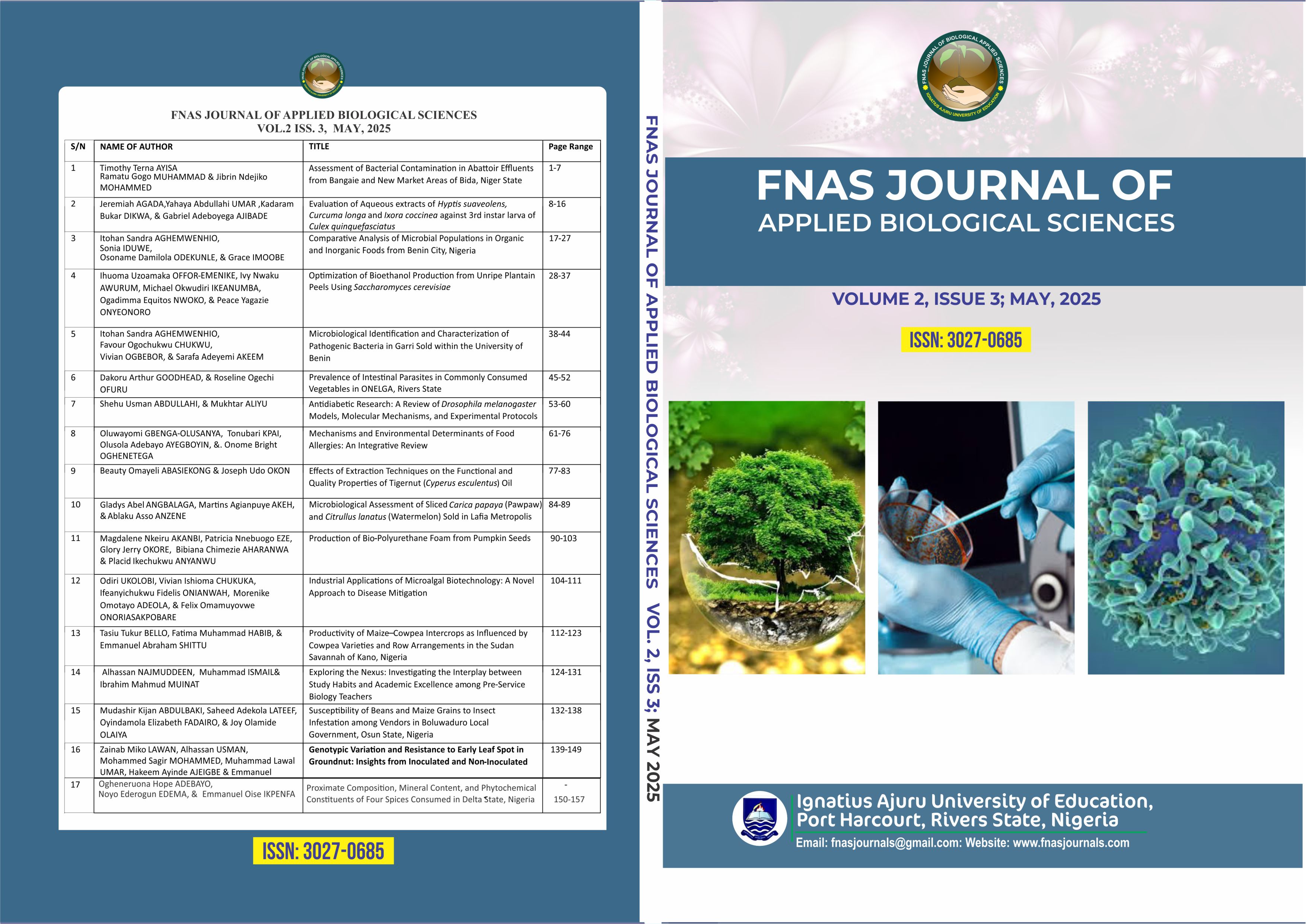Prevalence of Intestinal Parasites in Commonly Consumed Vegetables in ONELGA, Rivers State
DOI:
https://doi.org/10.63561/jabs.v2i3.932Abstract
Leafy vegetables are important diet to the Niger Delta people. It is rich in dietary sources of various immune-boosting natural chemicals which protect human health against diseases. However, it could also be a medium through which humans can acquire infections with human intestinal helminths if taken without observing proper hygiene. This study aimed to ascertain the status of helminth parasites on leafy vegetables cultivated and sold in five (5) rural communities of Onelga. A total of 300 samples of leafy vegetables were purchased randomly across the markets, and parasitological analysis of the samples was done using sedimentation and centrifugal techniques. results of the study revealed a 40% prevalence of contamination of leafy vegetables with various parasite species. Parasites detected were Ascaris lumbricoides, Trichuris trichiura, Giardia lamblia, Entamoeba histolytica, and Hookworm species. Ascaris lumbricoides was the most frequently observed parasite species detected from the study. Higher intensity of contamination with 58.3% was observed in Obirikom community. The monthly distribution of parasite species observed showed that July had higher contamination of 28.6%. Results from seasons show wet season recorded a higher prevalence of 55.7%. Thus, this survey revealed that leafy vegetables cultivated and sold for human consumption could be a risk of intestinal helminth infections. Adequate sanitary measures of washing with water and common household salts should be employed to reduce the load of parasites before cooking and consumption.
References
Uneke, B.I., & Udegbunam, R.O. (2015). Geohelminth contamination of common fruits and vegetables in Ebonyi State, Nigeria: The public health implication, AASCIT Journal of Bioscience 1(2), 15-19
Maikai, V.A., Watti, J.E., Okolo, A., & Desmond, B. (2019). Geohelminth contamination of raw vegetables as sold in some selected markets in Metropolis, Nigeria. Nigerian Journal of Parasitology. 40 (2), 181-185 DOI: https://doi.org/10.4314/njpar.v40i2.10
Bekele, F., Tefera, T., Biresaw, G., & Yohannes, T. (2017). Parasite contamination of raw vegetables and fruits collected from selected local markets in Arba Minch Town,Southern Ethiopia. Infectious Disease of Poverty, 6(1), 19-23 DOI: https://doi.org/10.1186/s40249-016-0226-6
Bartosova, B., Koudela, B., & Slana, I. (2021). Detection of cyclospora cayetanensis, echinococcus multilocularis, toxocara spp. and microsporidia in fresh produce using molecular methods: A Review. Food and Waterborne Parasitology, 23 DOI: https://doi.org/10.1016/j.fawpar.2021.e00124
Rostami, A., Ebrahimi, M., Mehravar, S., Fallah Omrani, V. F., Fallahi, S., & Behniafar, H. (2016). Contamination of commonly consumed raw vegetables with soil transmitted helminth eggs in mazandaran province, Northern Iran. International Journal of Food Microbiology, 225, 54–58. DOI: https://doi.org/10.1016/j.ijfoodmicro.2016.03.013
Federal Ministry of Health (2013): Nigeria Master Plan for Neglected Tropical Diseases (NTDs) 2013-2017, Abuja; Federal Ministry of Health, 142p
Omowaye, O.S., & Audu, P.A. (2012). Parasites contamination and distribution on fruits and vegetables in Kogi, Nigeria. Cibtech Journal of Bio-Protocols, 1(1), 44 - 47
Klapec, T., & Borecka, A. (2012). Contamination of vegetables, fruits and soil with geohelminths eggs on organic farms in Poland. Annuals Journal of Agricultural and Environmental Medicine 19(3), 421- 42
Idahosa, O.T. (2011). Paraistic contamination of fresh vegetables sold in Jos Markets. Global Journal of Medical Research, 11 (1), 21-25
Abe, E.M., Ajah, L.J., Ayuba, S.O.,Mogaji, H., & Ekpo, U.F. (2016). Geohelminths contamination of fuits and vegetables sold in Lafia Markets. Annual Research and Reviw in Biology, 11(2), 1-8 DOI: https://doi.org/10.9734/ARRB/2016/25566
Sahira, K., & Al-Abboodi, A.K. (2023). Parasitological contamination of raw vegetables collected from selected local markets in Maysan Province, South of Iraq, Nigerian Journal of Parasitology 44(2). 464-473 Vishvakarma, P., Mandel ,S., & Verma, A. (2023). A review on current aspects of nutraceuticals and dietary supplements. International Journal of Pharma Professional Research (IJPPR), 14(1),78-91 DOI: https://doi.org/10.4314/njpar.v44i2.20
Paller, V.G.V., Macalina-Ramirez, C.A., & Bandel, M.Z. (2022). Environmental contamination with parasites in selected rural farms in the philippines: impacts of farming practices on leafy greens food safety. Parasitology, 149(4), 482-489 DOI: https://doi.org/10.1017/S0031182021002031
Hassan, A., Farouk, H., & Abdul-Ghani, R. (2017). Parasitolgical contamination of freshly eatenvegetables collected from local markets in Alexandria, Egypt: A Preliminary Study. Food Control, 26(2), 500-503 DOI: https://doi.org/10.1016/j.foodcont.2012.01.033
Christiana Cudjoe, D., Balali, G.I., Titus, O.O., Osafo, R., & Taufiq, M. (2022): Food safety in Sub-Sahara Africa, An insight into Ghana and Nigeria. Environmental Health Insights, 16:11786302221142484 DOI: https://doi.org/10.1177/11786302221142484
Kadiene, E.U., Dele-Nwajei, B.E., & Oyedokun, I.S. (2023). The Influence of Inadequate Handling Conditions on the Prevalence of Parasites in Commonly Consumed Fluted Pumpkin Leaves (Telfaire occidentalis) in Delta State, Nigeria. Nigerian Journal of Parasitology 44(2), 304-315 DOI: https://doi.org/10.4314/njpar.v44i2.3
Simeon-Oke, I.A.,Afolabi, O.J., & Obasla, O.P. (2014). Parasitic contamination of fruits and vegetables sold at Akure Metropolis, Ondo State, Nigeria, Nigerian Researcher, 6(12), 30 - 36
Cheesbrough, M. (2009). District laboratory practice in tropical countries part 1, second edition, Cambridge University, Pp 200-297
Odikamnoro, O.O, Omowaye, O.S., & Agbom, M.C. (2013). Soil helminthasis on farm land in Ebonyi State, Nigeria, Unique Research Journal of Agricultural Sciences 1(5), 070-075
Su, G.L.S.., Mariano, C.M.R., Matti, N.S.A., & Ramos, G.B. (2012). Assessing parasitic infestation of vegetables in Selected Markets in Metro Manila, Philippines. Asian Pacific Journal of Tropical Disease 2(1), 51-54 DOI: https://doi.org/10.1016/S2222-1808(12)60012-7
Olyaeri, A., & Hajivandi, L. (2013). Parasitological contamination of markets and farms in vegetables consumed in Southern Iran. Global Veterinaria, 10(3), 327-33
Oladele, O.I. (2011). Contribution of indigenious vegetables and fruits to poverty alleviation in Oyo State, Nigeria, Journal of Human Ecology, 34(1), 1-6 DOI: https://doi.org/10.1080/09709274.2011.11906362
Nwoke, E.U., Ibiam, G.A., Odikamnoro, O.O., Umah, O.V., Ariom, O.T., & Orji, I. (2013). Examination of soil samples for the incidence of Geohelminth Parasites in Ebonyi North-Central Area of Ebonyi State, South-East of Nigeria. Scholar Research Library, 5(6), 41-48
Richard, Skolnik & Ambareen, Ahmed (2010). Ending the neglect of neglected tropical diseases. policy brief, inform empower advance (PRB) www.prb.org
Eze Chinwe N., Owhoeli Ovutor, Goodhead Dakoru, A., & Nwankwo, F.C. (2024) Parasitological, bacterial and fungal evaluation of some ready-to-eat foods sold by vendors in Port-harcourt, Rivers State, Microbiology Research Journal Internationl 34(2), 32-43 DOI: https://doi.org/10.9734/mrji/2024/v34i21430





